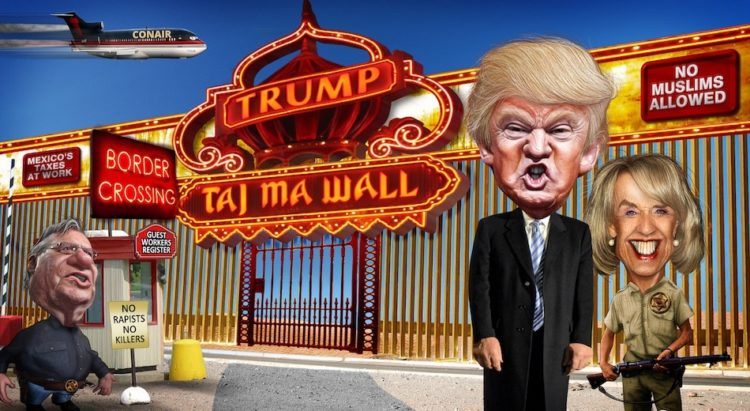
Photo credits: Donkey Hotey.
US President Donald Trump’s ‘America First’ pledge has rattled India’s software services sector, and clearly split the industry in two. The first set is worried employment will suffer as 60 percent of the country’s IT exports go to the US, and the second group is championing the benefits of a potential “reverse brain drain” this could trigger.
In truth, the bill, introduced by Congresswoman Zoe Lofgren and which seeks to encourage companies to recruit American workers, is a long way from becoming law.
However, major Indian IT outsourcing companies such as Tata Consultancy Services and Infosys will be the biggest victims if the changes do come to pass. Indian IT companies receive the largest share of the 65,000 H-1B work visas issued by the US every year.
India suffers in intellectual property as her impactful innovators move abroad.
Tech shares nosedived on Tuesday on reports that Trump may remodel the H-1B visa program, which allows skilled foreigners to work in the US. Shares of TCS, India’s biggest private sector employer, recovered slightly till Friday to end at 4 percent lower. Shares of Infosys and Wipro remain unchanged since Tuesday.
While markets turned jittery, some industry veterans see hope in the turmoil. “The effect [of visa changes] will be twofold: We will bring more of the work offshore, which is a long-term advantage for the Indian IT industry. Besides, it will drive Indian companies up in the value chain, because the kind of people who we send will be premium people, people who are consultants and highly experienced and skilled,” Ashok Soota, former president of Wipro and Executive Chairman of Happiest Minds Technologies, told CNN-News18.
But no matter which side of the fence you stand, the fact is that the industry has likely pushed the frenzy buttons too soon.
To start with, Trump’s stand on letting in foreign skilled labor has been a series of flip flops. In October 2015 Trump favored bringing skilled foreign workers into the US, “as long as they come legally.”
Now he lobbies for increases in H-1B visa fees, or even scrapping the visa, to pressurize companies into hiring domestic workers. Kris Lakshmikanth, CEO of Headhunters, feels the Trump regime may not eventually go for as radical an overhaul as people fear.
“It is practically impossible to close an economy in times of globalization. Trump has given several contradictory statements on foreign labor while campaigning,” Kris says.
Been there, done that
This isn’t the first time India has stood on the throes of a potential historic homecoming of talent. The burst of the dotcom bubble in 2001 led several non-resident Indians to return home, many of them tech workers. The global economic crisis beginning in 2008 forced many to relocate. After that, the startup boom in India successfully tempted many back home.
In all cases, the much-hyped reverse brain drain ended up being more a trickle than a flood.
Indian-origin scientists and engineers in the US grew 85 per cent between 2003 and 2013, according to a study by the National Science Foundation.
The numbers of Indian students on US campuses have also been growing. In 2015-16, the figure was at 165,918, 25 percent more than the previous year, according to the annual Open Doors report by the Institute of International Education.
The reasons for this are varied. While a lot of those that came back did find fulfilling careers in the country, there are perception issues that stop many young Indians from returning home. An anecdotal survey of Indian tech industry workers in the US show most of them are wary of what jobs they could land back home, apprehensive of India’s poor administration and fabled red tape, and often want to stick out in the US till all options have played out before making the call to return.
It is practically impossible to close an economy in times of globalization.
After all, many of the country’s peripatetic expats like Sundar Pichai and Satya Nadella have been highly successful abroad.
Meanwhile, India suffers in the field of intellectual property as her impactful innovators move abroad. The number of international patent applications filed from the country stood at 1,423 in 2015, compared with Japan’s 44,235, China’s 29,846 and South Korea’s 14,626 in the same period.

Photo credit: Magharebia.
India winning?
It is easy to see why optimists think the Trump scare may finally do for India what the country has been trying hard to do since ages – bring back its engineers and scientists.
There are some green shoots as well. Indians living in the US have started to make cold calls to headhunters exploring opportunities here. Kris himself has received about 30 such queries in the last month. Typically, he would receive that many calls over three months.
But in truth, it is mostly going to be the middle rung of engineers and tech workers who would come back as a result of job cuts due to visa changes, if any, says Neil Shah of Counterpoint. India produces nearly 1.5 million engineers every year. “It is unlikely that an influx of more average tech talent in the country will change its technological future,” he added. In any case, when people talk of the positive impacts of a reverse brain drain, they aren’t talking about IT offshoring jobs- they are talking about talented visionaries and scientists.
There will be some respite, of course. Last year, a New Delhi-based employment solutions company, Aspiring Minds, conducted an employability study based on 150,000 engineering students and found barely 7 per cent suitable for core engineering jobs.
Neil Shah of Counterpoint Research says that if skilled manpower is forced back to India, the tech sector could finally fill its huge talent gap, especially in product development, hardware, and upcoming technology such as artificial intelligence and natural language processing.
“Some of our best brains are in the US, as residents or on on-site projects. Their exposure to advanced and specialized technology can be utilized here. It will help the sector in hiring good talent within the country,” K Sudarshan, global vice president of executive search firm EMA Partners, says.
When people talk of the positive impacts of a reverse brain drain, they aren’t talking about IT offshoring jobs.
Employers across the world are facing the most acute talent shortage since the recession, according to the Talent Shortage Survey. In India, 48 percent of employers reported difficulties filling job vacancies due to talent shortages in 2015.
A study by Singapore-based Emeritus Institute of Management in November among executives of IT and IT services sector pegs the percentage much higher at 85 percent.
Baby steps
India’s Narendra Modi-led government has taken measures to woo back and retain scientists. The government is offering fellowships and opportunities to work in reputed organizations to ensure that scientists return home. It’s also encouraging large Silicon Valley corporations like Apple to set up manufacturing in India.
India’s union minister for science and technology Harsh Vardhan recently noted the rise in the number of scientists returning to the country. “Around 175-180 scientists have returned to India in the recent past.”
What really seems to be working in the country’s favor is a combination of new opportunities, better infrastructure, and government impetus on startups.
“There is ample opportunity here now, for them [NRIs] to come back. It will mostly be the middle-rung of employees who will come back. They can create jobs here with new and innovative ventures,” says Ravi Gururaj, founder of QikPod and chair of NASSCOM’s product council.
Modi’s Make in India campaign has grabbed headlines, and indeed there is some progress. But the growth is restricted to software and ecommerce. The infrastructure required to encourage hardware innovation has till now eluded engineers in India.
“We need future-oriented planning, consistent policies, public and private partnerships for meaningful reform, and massive infrastructure improvements to facilitate the growth of jobs that peer countries are eager to poach,” Vidya Shankar of Grant Thornton says.
Unless these fundamental conditions are met, India will continue to see its talent fly off to greener pastures, changes from a Trump government notwithstanding.
(This analysis includes the opinions of the writer.)
This post The potential H-1B visa curbs won’t change shit for India. This is why. appeared first on Tech in Asia.
from Tech in Asia https://www.techinasia.com/trump-h1b-india-talent
via IFTTT
No comments:
Post a Comment